If you have decided to grow milkweed to help monarch butterflies on their migratory routes, let me join our fluttery orange friends in thanking you!
Since milkweeds are larval host plants for monarchs, increased plantings of these wildflowers will help populations of these regal butterflies in their efforts to make their grand migrations, a phenomenon which is in peril.
Now you just need to pick the best species for your area, since all milkweeds are not equal in the eyes (or tastebuds) of our black and orange buddies.
Monarchs (Danaus plexippus) depend on regionally available native milkweed species for food as they make their long trek.
So, if you don’t plant native species, the monarchs’ migratory pattern might be interrupted, causing harm to these winsome creatures. I’ll explain more about this just a little later.
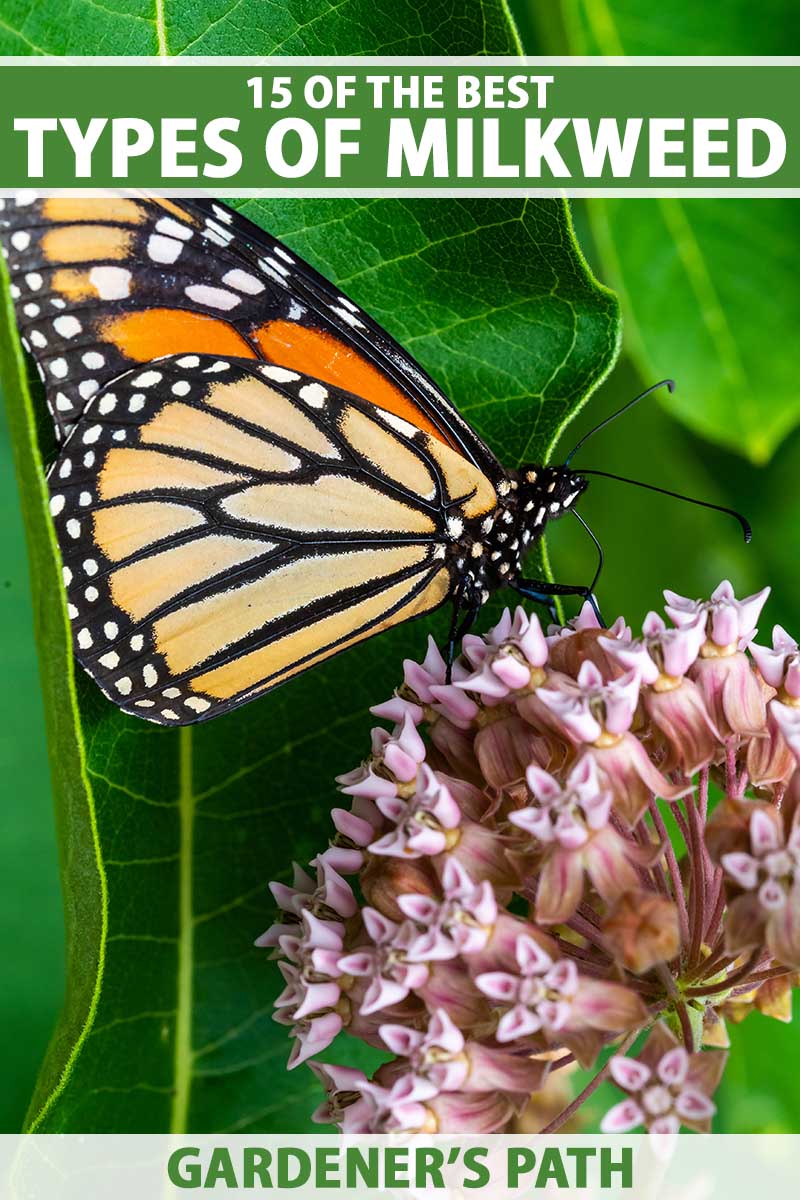
We link to vendors to help you find relevant products. If you buy from one of our links, we may earn a commission.
In this article, I’m going to give you an overview of 15 types of milkweed that are important to monarch butterflies, so that you can find the best species for your region.
You’ll find at least one species that will work for you no matter where you are in the continental US, as well as some options for Canadian gardeners.
I’ll also mention one species that is well-suited for Mexico, the Caribbean, and parts of South America.
In addition to the plants’ native regions, I’ll provide information on USDA Hardiness Zones, soil, light, and water needs, to help you pick the best one not just for your region, but for your specific growing conditions as well.
You’ll learn what to expect from these plants in terms of height, foliage, and flower color – as well as tips on where to find seeds when they are commercially available – and ideas on how to use these native plants in the landscape.
Here’s a sneak peek of the recommended Asclepias species list:
15 of the Best Types of Milkweed for Monarchs
But first, let’s look at one species you should avoid if you live in the US or Canada.
Native to Mexico, the Caribbean, Central America, and parts of South America, A. curassavica can also be found growing wild in Florida, Texas, California, and Louisiana, where it is a non-native, introduced species.
Also known as “bloodflower,” “sunset flower,” or “tropical milkweed,” this plant has very brightly colored, striking flowers that are red and yellow.
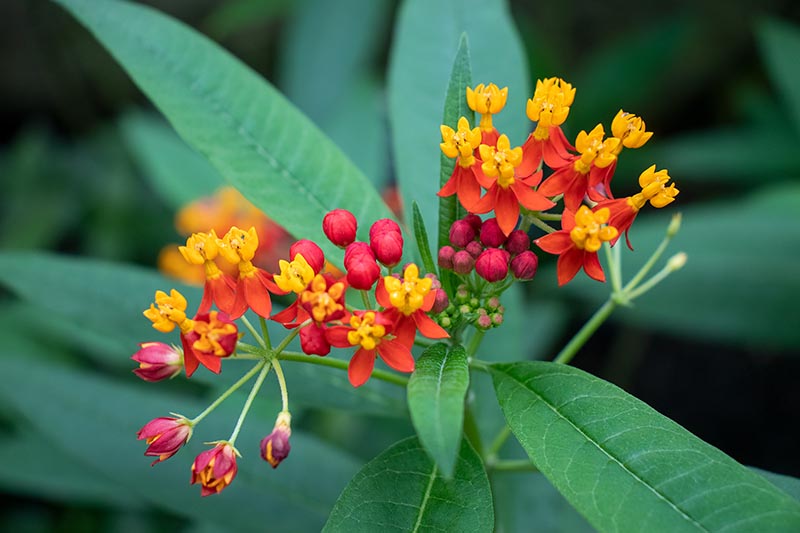
There are a couple of reasons you’ll want to avoid this plant when growing milkweeds for monarchs in the United States or Canada.
Here’s what the research says:
In a study published in the journal Proceedings of the Royal Society B: Biological Sciences, Dara Satterfield and colleagues explain that this plant discourages migration in monarchs, and puts these butterflies at a higher risk of being infected by parasites.
These two consequences of planting bloodflower outside of its native regions make the plant a potential detriment to the overall health of monarch butterfly populations.
If you already have bloodflower in your yard, Satterfield and her co-researchers recommend cutting back these plants to about six inches every fall (unless they die back on their own), and eventually replacing them with species native to your region.
In regions where this plant is native (such as Mexico, the Caribbean, Central America, and parts of South America), bloodflower does not cause a problem for monarchs and can be grown safely.
In the US and Canada, however, it’s best to look for suitable alternatives – you’re about to discover fifteen of them!
1. A. asperula
Our first selection goes by the common name “antelope horns.”
A. asperula is also known as “antelopehorn milkweed,” “spider antelopehorns,” “green-flowered milkweed,” and “spider milkweed.”

This species is native to the southwestern and south-central US, which includes Texas, Oklahoma, Kansas, Nebraska, New Mexico, Colorado, Arizona, Utah, Idaho, California, and Nevada.
Antelope horns is hardy in Zones 7 to 9.
This plant can have a sprawling or upright growth habit, with stems reaching one to two feet in length. Leaves are narrow and often folded in half lengthwise.
If you’re a fan of green flowers, you’ll want to have a good look at this selection. The ball-shaped inflorescences of this species are greenish yellow tinged with maroon, and they bloom from April through June.
A. asperula has very low water requirements once established, and in the wild it is typically found growing in desert areas.
It requires full sun and thrives in well-drained soils, including sand, clay, caliche, and loam.
This species would make a fascinating specimen in a xeriscaped garden.
In addition to monarchs, A. asperula is also a larval host for queen butterflies (Danaus gilippus).

If antelope horns seems like the right species for your region and growing conditions, you’ll find packs of 10 seeds from Buy Rare Seeds via Amazon.
2. A. cordifolia
Our next suggestion is one that might be considered particularly heartfelt.
A. cordifolia is commonly known as “heartleaf milkweed” – like its common name, its species name “cordifolia” also refers to its heart-shaped leaves.

This species is native to the West Coast of the US, including California, Nevada, and Oregon, and is hardy in Zones 7 to 10.
A. cordifolia is sometimes also called “purple milkweed” but is not to be confused with A. purpurascens, which is also referred to by that same common name.
Blooming in spring and summer, A. cordifolia produces clusters of reddish-purple flowers that are held in a loose panicle.
Upright plants reach one to two feet tall, and their heart-shaped leaves are blue-green in color, and tinged with purple.
Requiring very little water, this plant can grow in full sun to part shade. It grows well in rocky soils or those containing decomposed granite.
This species is a larval host for monarch and queen butterflies, as well as Isabella tiger moths (Pyrrharctia isabella) and Clio tiger moths (Ectypia clio).
If you have a rocky slope in need of planting, A. cordifolia would be an excellent plant to consider.
3. A. eriocarpa
Our next selection may make you want to reach out and touch it.
A. eriocarpa is known for its wooly seed pods, which give it its common name, “woolypod milkweed,” as well as its species name, “eriocarpa.”
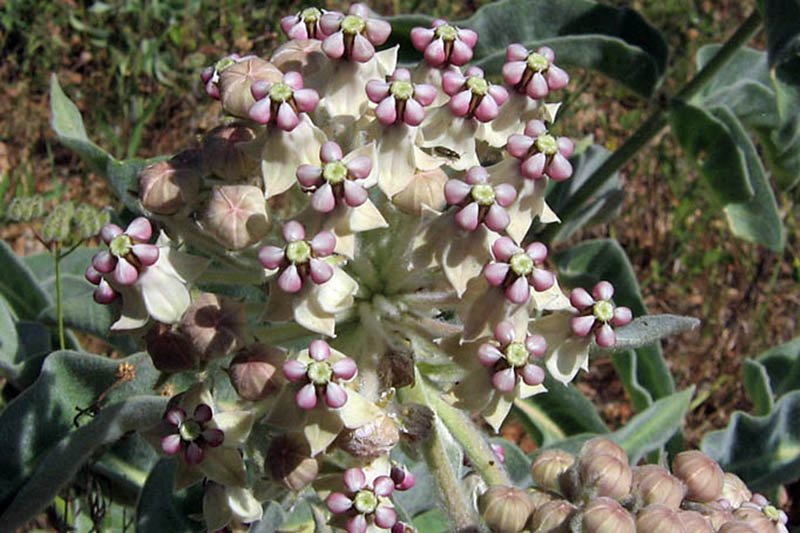
Hardy in Zones 7 to 10 and native to California, Nevada, and Baja Mexico, this species is also known as “kotolo” or “Indian milkweed.”
This plant was used for fiber and medicine by native Americans such as the Ohlone and Luiseno peoples.
Increasing the tactile interest of this plant, the wavy foliage of A. eriocarpa is often coated in white hairs, giving it a silvery appearance. Leaves are oval or lance-shaped, and arranged in pairs or whorls.
Blooming from May through October, this plant holds pink and white or cream flowers aloft on upright stalks that reach one and a half to three feet tall.
Woolypod milkweed requires full sun and tends to grow in dry areas. It is very adaptable regarding soil, growing in many different types of soil, including clay.
This species is drought tolerant and has very low water needs once established.
In addition to being a larval host to both monarch and queen butterflies, it is also a host to Isabella tiger moths and Clio tiger moths.
In the landscape, this species can be used as a specimen or for mass plantings.

Ready to get your tactile appreciation on? You’ll find A. eriocarpa seeds available for purchase in packs of 10 seeds from Buy Rare Seeds via Amazon.
4. A. erosa
Our fourth selection is a true desert dweller.
Another western native, A. erosa also goes by the common name “desert milkweed.”
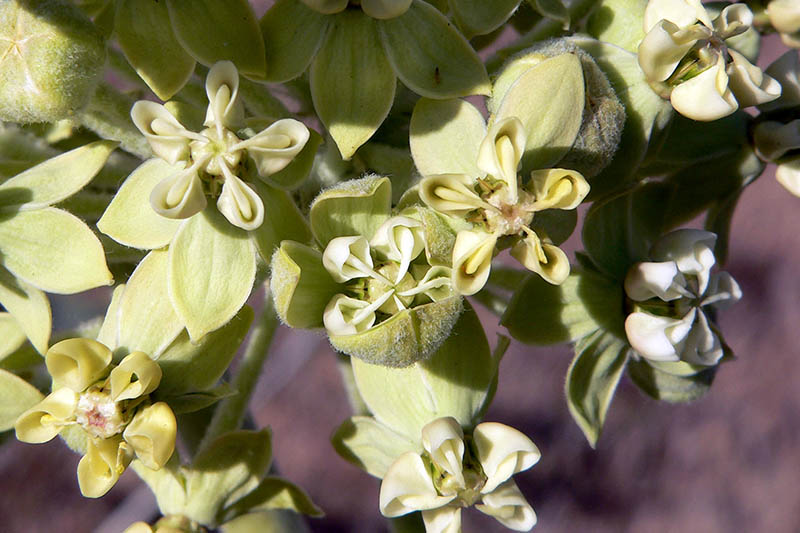
This species is hardy in Zones 4 to 10. Its native habitat is the desert southwest, specifically southern California, Arizona, Nevada, Utah, and northern Baja California.
This plant has an upright growth habit and grows to be one to three feet in height, with pale silvery green to dark green leaves.
Ball-shaped flower clusters are greenish yellow, pale yellow, or cream colored, and appear in spring, summer, and fall.
As its common name suggests, this is a desert plant. It has very low water requirements and thrives in dry locations with little organic matter.
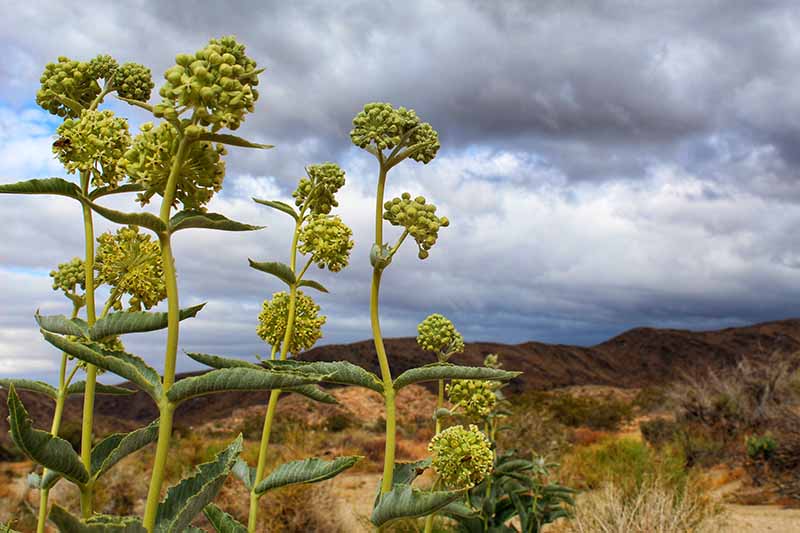
Desert milkweed requires full sun and grows best in soils consisting of granite, sand, or lean clay.
A. erosa can be used in xeriscapes, on mountain slopes, and in disturbed soils. It serves as a host to monarch and queen butterflies as well as Clio tiger moths.
5. A. exaltata
With this next selection, we are leaving arid lands behind for now and heading east to more clement conditions.
Known as “tall milkweed,” A. exaltata is native to eastern North America.
In the US, it ranges from Maine south to Georgia and Alabama, and west to Tennessee, Missouri, Iowa, and Minnesota. In Canada, it is native to Ontario and Quebec.

A. exaltata is hardy in Zones 4 to 7.
It has an upright growth habit and can grow to be up to five feet tall. Its green leaves are elliptical and pointed, with a smooth top side and a hairy underside.
With its leaves and its tall stature, it bears some resemblance to pokeweed, giving this species another common name, “poke milkweed.”
Rather than holding its flowers in dense, upright spheres like some Asclepias species, A. exaltata has open clusters of white and lavender flowers that hang delicately from the inflorescence, blooming from May through August.
A. exaltata has moderate moisture requirements and grows best in part shade. This species needs soil that is rich in organic matter and does well when grown at forest edges, so it would be well placed at the edge of a natural area.
In addition to its importance for monarchs, A. exaltata is also beneficial for dogbane tiger moths or delicate cycnia (Cycnia tenera) and the unexpected cycnia (Cycnia inopinatus).
6. A. fascicularis
Our sixth selection takes a departure from the most well-known appearance of the Asclepias genus with its stout stems and large, well-spaced leaves – this one is quite delicate looking.
A. fascicularis, otherwise known as “narrowleaf milkweed,” is native to parts of the western US, California, Idaho, Nevada, Oregon, and Washington in particular.
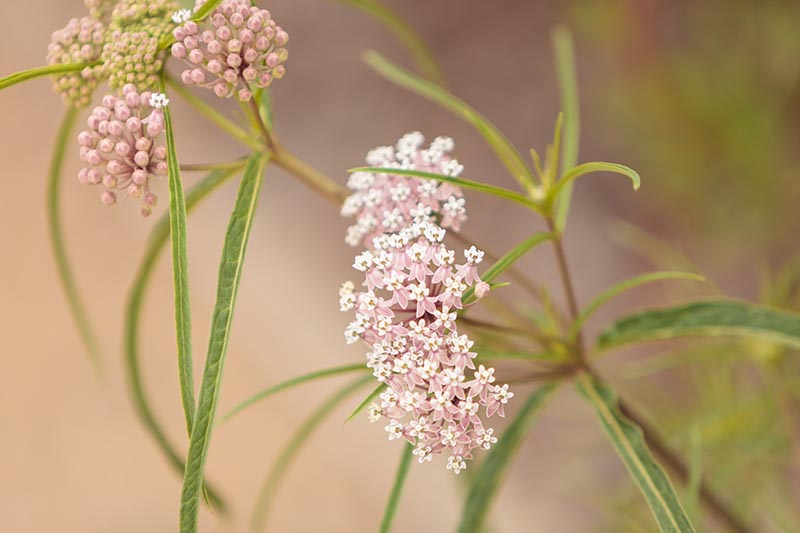
Also known as “Mexican whorled milkweed,” this species is hardy in Zones 6 to 10.
The plant reaches 20 to 40 inches tall with an upright growth habit, and a wispy appearance due to its narrow leaves. The long, narrow leaves are pointed, and green to grayish-green in color.
The flower heads are soft pink, with individual flowers that are pink and white, blooming from June to September.
The seed pods are smooth, narrow, and tapered. These can be removed before they split to prevent the growth of unwanted volunteers.
A. fascicularis is extremely drought tolerant and can grow without additional irrigation in xeric gardens after it’s established, though it will also tolerate moist soils.
This species requires full sun, and grows well in clay soils and on slopes.

In addition to its importance to monarch butterflies, A. fascicularis is also a host to queen butterflies, Isabella tiger moths, Clio tiger moths, and hitched arches moths (Melanchra adjuncta).
Native bees and honeybees also forage from this species.
Due to its tendency to spread, A. fascicularis would be best used where its expansiveness will be a boon rather than a burden, such as in a naturalized planting.
Fancy some delicacy in your West Coast native garden? You’ll find narrowleaf milkweed seeds available for purchase in packs of 150 milligrams at Botanical Interests.
7. A. humistrata
It seems there is a milkweed for every different ecological niche, and this next one evolved in sandhill habitats dominated by longleaf pines.
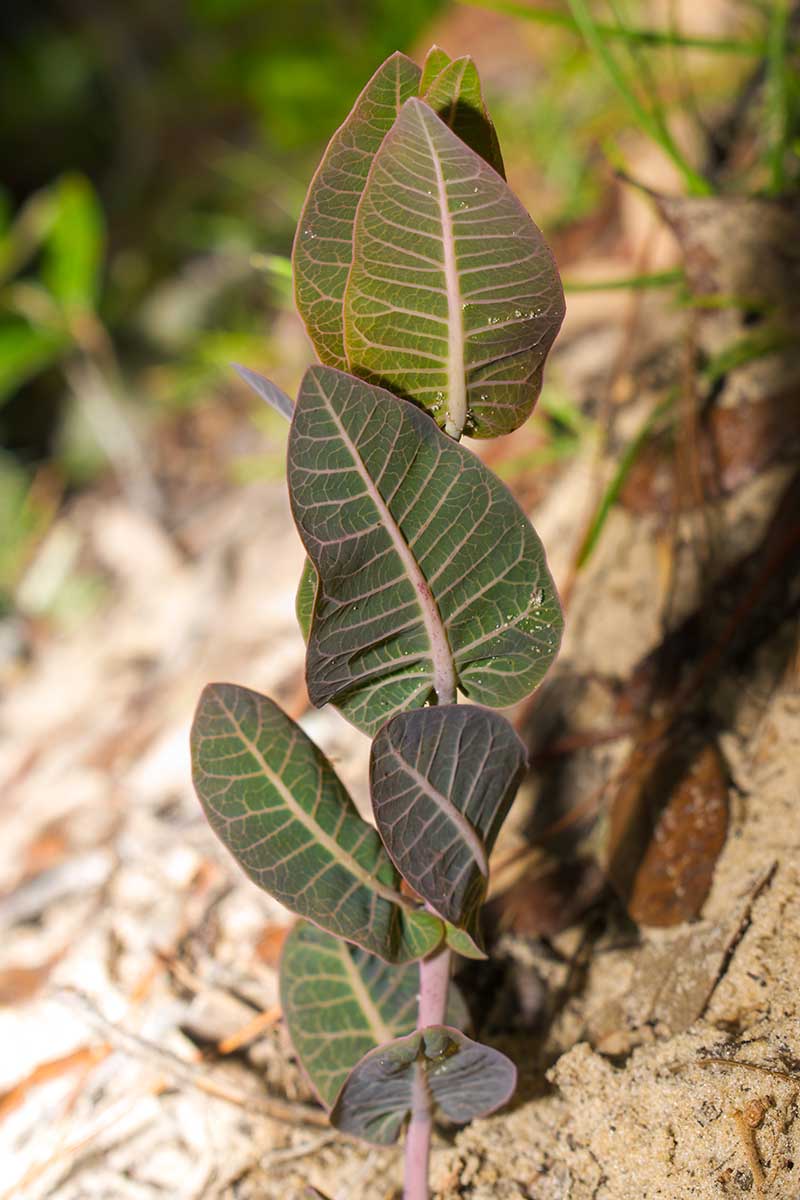
Sandhill milkweed, or A. humistrata, is native to the southeastern United States, in Florida, Georgia, South Carolina, North Carolina, Alabama, Mississippi, and Louisiana in particular.
This species is hardy in Zones 8a through 9b.
Also called “pinewoods milkweed,” this plant can have either an upright or a sprawling growth habit. Its broad leaves are green with a purple tinge and lavender veins. Stems grow to a length of one to three feet.
The flower clusters are a soft shade of creamy pink or purple, blooming from March through June.

A. humistrata does best in full sun but can tolerate some light shade as well.
In its native habitat it grows in dry, sandy soils, and is tolerant of very hot and dry conditions.
It is a larval host for monarch and queen butterflies, and is also attractive to native bees.
Ranger Scott Davis at St. Marks National Wildlife Refuge in Florida says this species may be the most important variety for monarchs in the southeast because its bloom time syncs up well with the arrival of monarchs to the region.
A. humistrata can be used in naturalized plantings and will do well in hot, dry roadside conditions if soil conditions are met.
8. A. incarnata
As I was saying, there’s an Asclepias adapted to seemingly every habitat type, even swamps.
Meet A. incarnata, more commonly known as “swamp milkweed.”
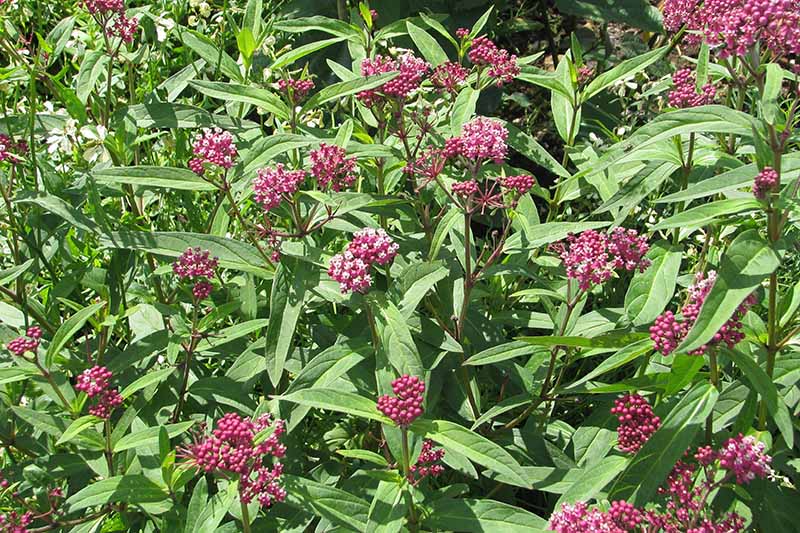
This species is very widespread, native to most of eastern Canada as well as most of the US, with the exception of Oregon, Washington, California, and Mississippi. This plant is hardy in Zones 3 to 9.
Also known as “rose milkweed,” “swamp butterflyweed,” and “pink milkweed,” A. incarnata can reach up to five feet tall.
This plant’s foliage is light green with narrow, lance-shaped leaves. These plants can take on a bushy appearance, as they are able to grow multiple stems from the same root crown.
A. incarnata blooms from mid-spring until early fall. Its showy flower clusters are pink, varying in hue from dusty rose to deep pink or reddish purple. White varieties are also available.

Swamp milkweed has smooth, narrow, tapered seed pods.
Unlike many other Asclepias species, this one is not tolerant of hot or dry conditions.
As its common name suggests, A. incarnata grows best in soils that are wet to moist. It also requires soil with lots of organic matter.
In the wild, it often grows in sunny openings in wet habitats, so give this plant full sun or part shade.
This plant is a larval host to both monarch and queen butterflies, and is an excellent source of forage for honeybees and native bees.
Moisture-loving A. incarnata can be used near ponds or in wetland gardens.
Ready to grow your own swamp thing? You’ll find pink swamp milkweed seeds available for purchase in packets of 25 at Earthbeat Seeds.
Or if you prefer the white variety – or some of each – seeds for these are also available at Eden Brothers.
9. A. perennis
Moving from wet to wetter, we come to our next selection, A. perennis, commonly called “aquatic milkweed.”
This short-lived perennial is native to coastal areas of the southeastern US and into the Ohio valley, including Florida, Georgia, South Carolina, Alabama, Arkansas, Louisiana, Mississippi, Texas, Tennessee, Kentucky, Illinois, Indiana, and Missouri.
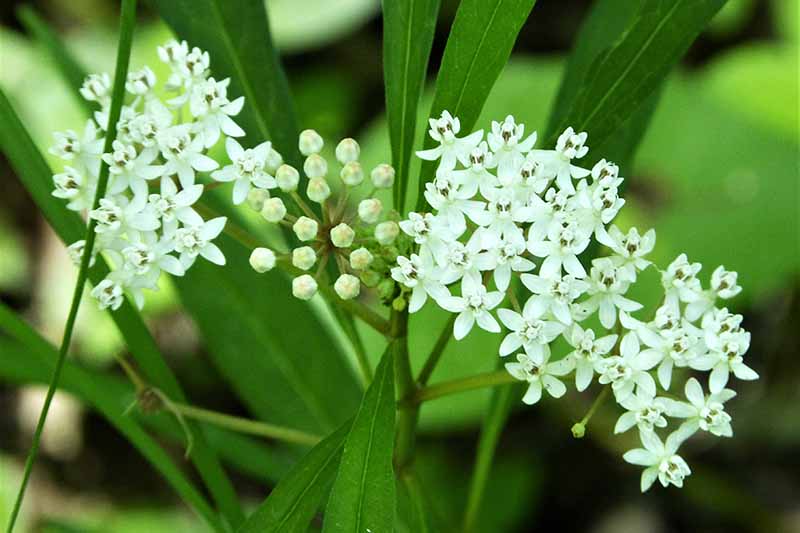
Hardy in Zones 8a to 10b, this species is also sometimes called “white swamp milkweed,” but it is not to be confused with the white variety of A. incarnata discussed above.
The stems of aquatic milkweed are purplish green with medium green leaves, and the plant grows from one to three feet tall.
Blooming from May through September, buds have a pink tint, opening to white. Flowers are held aloft in delicate umbels.
Unlike other species native to the US, aquatic milkweed seed pods lack the hairy “silk” that helps with seed dispersal, since its seeds are transported by water rather than wind.
A. perennis requires partial shade, and soils that are moist or wet.
This wetland species is a larval host to monarch, queen, and soldier or tropical queen butterflies (Danaus eresimus).
Aquatic milkweed can be used in bog gardens, near ponds, or in other wet areas.
10. A. purpurascens
If the rock star Prince were still with us, this would be the milkweed he would choose – and as luck would have it, it is native to his home state of Minnesota.
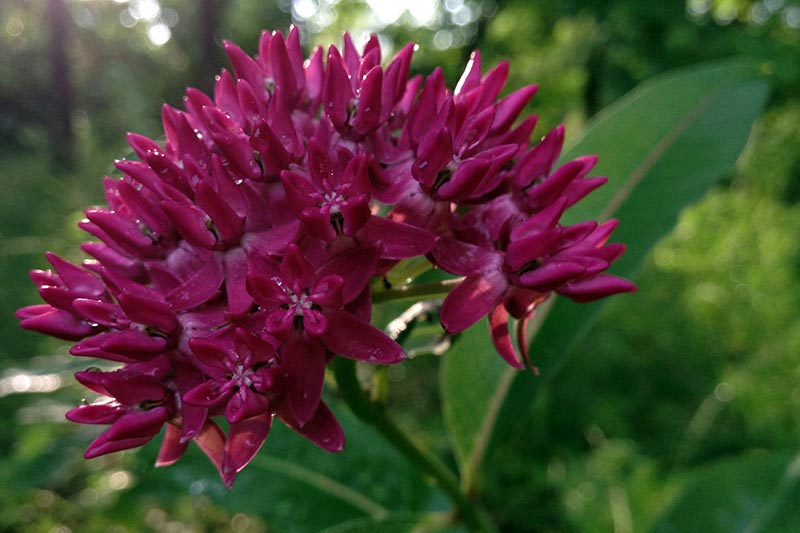
Commonly called “purple milkweed,” in addition to Wisconsin, A. purpurascens is native to much of central and eastern North America, and is hardy in Zones 3 to 8.
These plants reach two to three feet tall. Their leaves are broadly oval shaped and pointed, and green with central leaf veins that are purple in color.
Blooming from May through July, this species has intensely colored rose pink to reddish-purple flowers held in a dense, rounded umbel.
A. purpurascens is drought tolerant and can grow in dry to medium moisture conditions. It grows best in part shade, but can grow in full sun if provided with more water.
This plant is adaptable to various soil types, as long as the soil is well-draining.
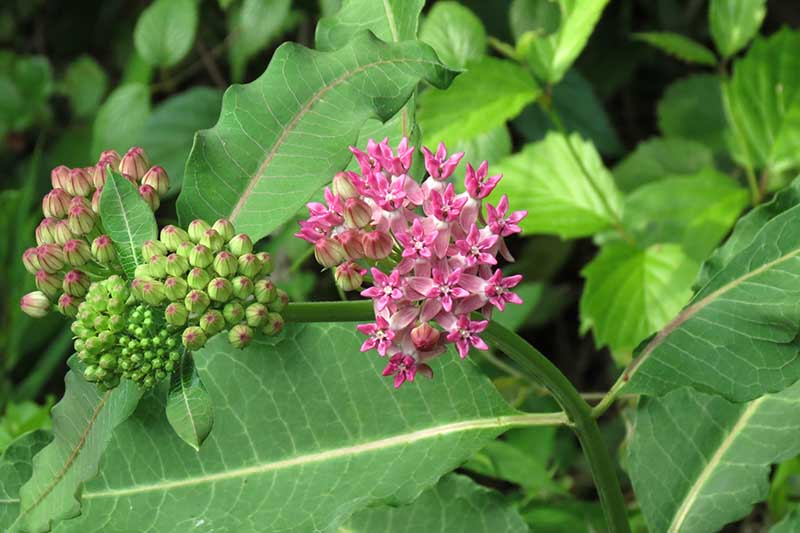
In addition to being a larval host for monarchs, this plant is also an important source of forage for other native pollinators and honeybees.
Purple milkweed can be put to good use in butterfly gardens, natural areas, meadows, or prairies.
This plant is endangered in some states. When procuring seeds, make sure to source them from an ethical seed source.
11. A. speciosa
Our next selection is a rare gem, a plant that thrives in the arid west while being graced with big, showy blooms.

Aptly named, showy milkweed, also known as A. speciosa, is a widespread species that is native to western and central North America and hardy in Zones 3 to 9.
Plants are upright with stout stems, and typically grow two to four feet tall, occasionally reaching six feet in height. Foliage is green to silvery green, and the leaves are oval shaped.
Blooming from June through July, showy milkweed has large pink and white, ball-shaped flower heads.
This species requires full sun but will adapt to different soil and water conditions, as long as the soil drains well. Showy milkweed is very drought tolerant once established.

Seed pods are large and often have a spiny or warty texture.
A. speciosa will spread via rhizomes or seeds, but it doesn’t spread as aggressively as its relative, common milkweed.
In the wild, this species grows in savannahs and prairies; in the landscape, try using it in butterfly gardens, bird gardens, prairies, meadows, borders, and natural areas. Showy milkweed is striking when used in a mass planting.
This plant is an important larval host for monarchs, as well as being an important source of forage for honeybees, bumblebees, and other native bee species.
Make this plant part of your garden spectacle – you’ll find A. speciosa seeds available for purchase in packets of 30 at Botanical Interests.
12. A. syriaca
If you were smitten by the showy blooms of A. speciosa but live outside of its native range, don’t worry, our next selection is its eastern counterpart.

Common milkweed, or A. syriaca, is hardy in Zones 3 to 9, and is native to all parts of the eastern and central US with the exception of Florida.
Upright plants can reach up to six feet tall and have stout stems, with leaves that are light to dark green on top with lighter green undersides. Leaf shapes are variable for this species and can be lance-shaped, oval, oblong, or elliptical.
Blooming from June to August, fragrant clusters of pink or purple flowers are ball-shaped, and droop slightly on their stems.
The seed pods of this species are large and can be warty or spiny.
Common milkweed has a very deep taproot, which can make transplanting live specimens difficult. However, that same deep taproot makes this plant very drought tolerant and allows it to grow well in dry soil, though it also thrives with moderate moisture.
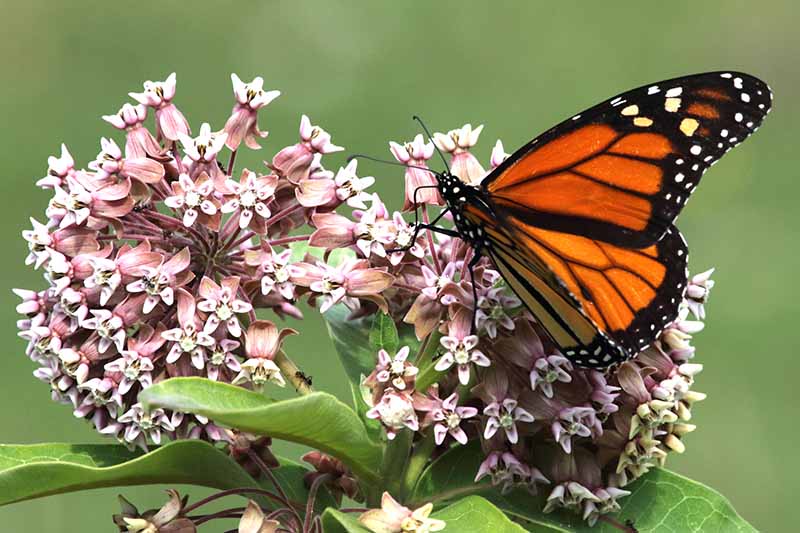
A. syriaca grows best in full sun but will tolerate some light shade. It requires good drainage, and can easily grow in poor soil, as evidenced by its tendency to grow in disturbed areas.
A historically widespread species in the eastern US, this species is an important larval host and source of forage for monarch butterflies.
It produces nectar 24 hours a day so it is also a tremendous source of forage for many other types of butterflies and moths, as well as honeybees, bumblebees, and other native bees.
Because of its tendency to spread, A. syriaca is best used in naturalized plantings, such as butterfly gardens, meadows, prairies, or natural areas. It can grow into colonies, creating a very large clump of flowers.
It may be called “common,” but even common things can be extraordinary.
To add this wonderful wildflower to your landscape, you’ll find both conventionally grown and organic common milkweed seeds for purchase in packets of 30 at Earthbeat Seeds.
13. A. tuberosa
If you’re starting to think that all of these selections are very nice, but you were hoping for an option with a brighter color, you’re about to have your wishes come true.
This selection is very much a US native, but one that has a very tropical appearance.
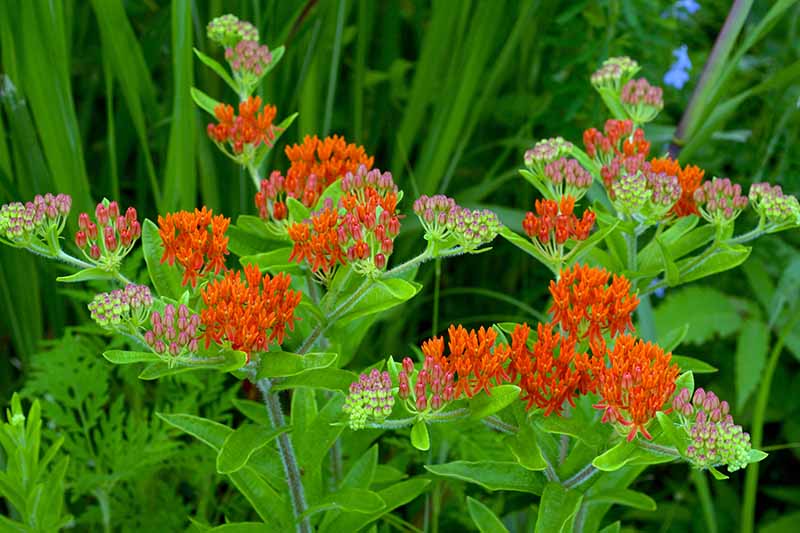
Along with A. speciosa and A. syriaca, A. tuberosa is one of the most wide-ranging plants in the Asclepias genus, making it a significant plant for our monarch friends in a large part of the US.
Commonly called “butterflyweed” (or “butterfly weed” written as two words), A. tuberosa is hardy in Zones 3 through 9, and is native to most of the eastern two-thirds of the United States, with a range that stretches from the East Coast westward to Minnesota, the Dakotas, Utah, and Arizona.
This Asclepias is also known by many other common names, including “butterfly milkweed,” “orange milkweed,” “pleurisy root,” and “chigger flower.”
Blooming from May through September, this species’ showy, flat-topped clusters of flowers are a brilliant reddish orange. Naturally occurring yellow varieties also exist.
Butterflyweed grows to be one to three feet tall, and has dark green leaves that are narrow and tapered. These plants can produce multiple stems from the same root crown.

Happy to grow in full sun or part shade, A. speciosa is drought tolerant once established and has low water needs.
As long as the soil is well-drained, butterflyweed can grow in many soil types, including sand, loam, clay, or limestone. It can thrive in soil that is dry to moderately moist, as long as the drainage requirement is met.
These can be mass planted to create striking orange drifts of color in the landscape, or they can be scattered for an occasional burst of color. Butterflyweed is great for use in borders, on slopes, and in meadows, prairies, or natural areas.
Butterflyweed is a larval host to monarch, queen, and gray hairstreak butterflies (Strymon melinus).
This plant is also an important source of forage for other pollinators.
Unique among Asclepias, A. speciosa lacks the milky sap that gives this genus its common name.
No one ever said monarch-friendly plants couldn’t look like exotic tropicals, and this species is evidence of that.
If you’re on board with these bright blooms, you’ll find organic butterflyweed seeds available for purchase in packets of 30 at Earthbeat Seeds.
A. tuberosa ‘Hello Yellow’ Seeds
And if you’d like to try a naturally occurring yellow variety of this species, ‘Hello Yellow’ is also available at Botanical Interests.
14. A. verticillata
If you were excited about the wispy selection mentioned above, the fascinating A. fascicularis, but were disappointed to discover its narrow native range, chances are this one will find a well-suited home in your habitat.
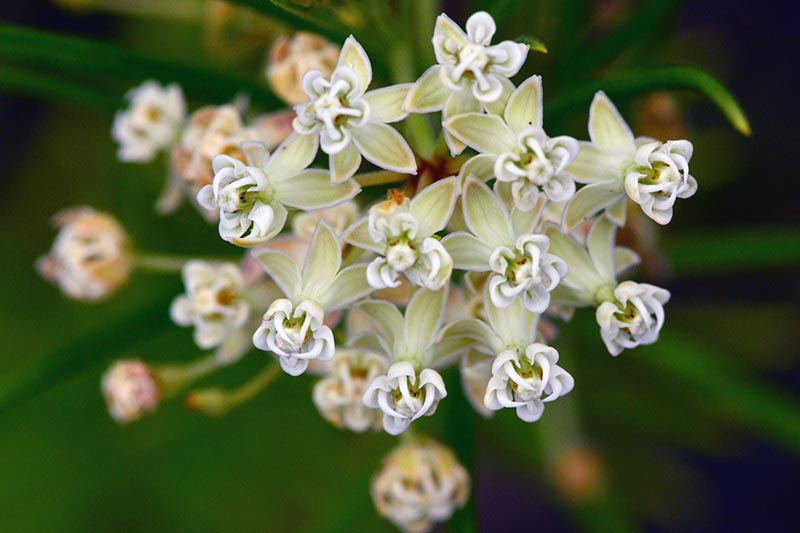
Commonly called “whorled milkweed,” “horsetail milkweed,” or “Eastern whorled milkweed,” A. verticillata is native to most of the Eastern two-thirds of the US, from Vermont south to Florida, and west to Arizona, Kansas, Wyoming, and Montana. In Canada, whorled milkweed is native to the provinces of Manitoba, Ontario, and Saskatchewan.
A. verticillata is hardy in Zones 4 to 9.
This plant is very wispy, with medium-green, needle-like leaves that are whorled around the stems, giving this species its common name. Plants grow to be one to two and a half feet tall.
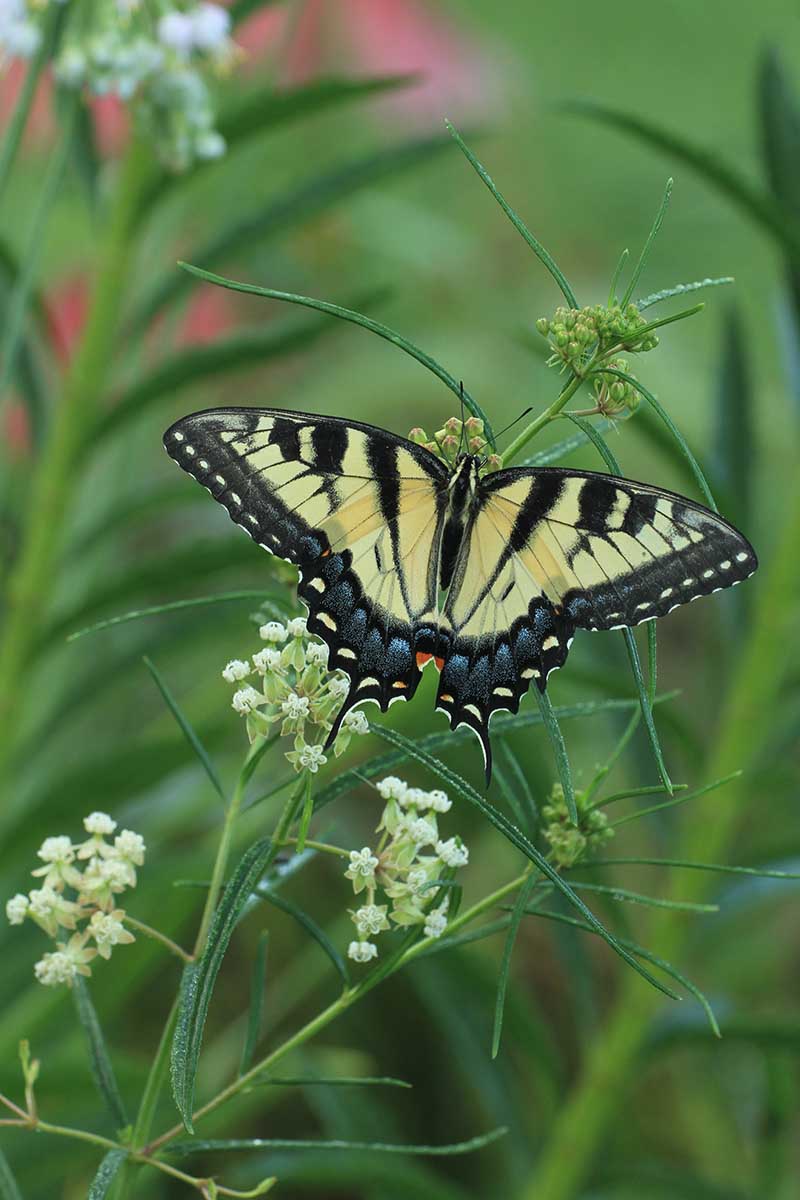
From April through September, white blooms appear in small, flat-topped clusters.
This woodland species grows well in soil that has a low to medium moisture content, and it can thrive in full sun or part shade.
A. verticillata requires well-drained soil and can tolerate the richer type of soil typically found in gardens, but it does best in sandy loam.
This larval host for monarchs also attracts other butterflies, such as swallowtails (species in the Papilionidae family), as well as honeybees, bumblebees, and other types of native bees.
A. verticillata has a delicate appearance with its small flowers and wispy foliage, and can work well as a filler in naturalized plantings.

You’ll find whorled milkweed available for purchase in packs of 100 seeds from Everwilde Farms via Amazon.
15. A. viridis
We come now to our last selection, a plant that may give you a feeling of déjà vu – or the notion of arriving at a bookend – since it shares some commonalities with our first selection, and the two even overlap in their native ranges.
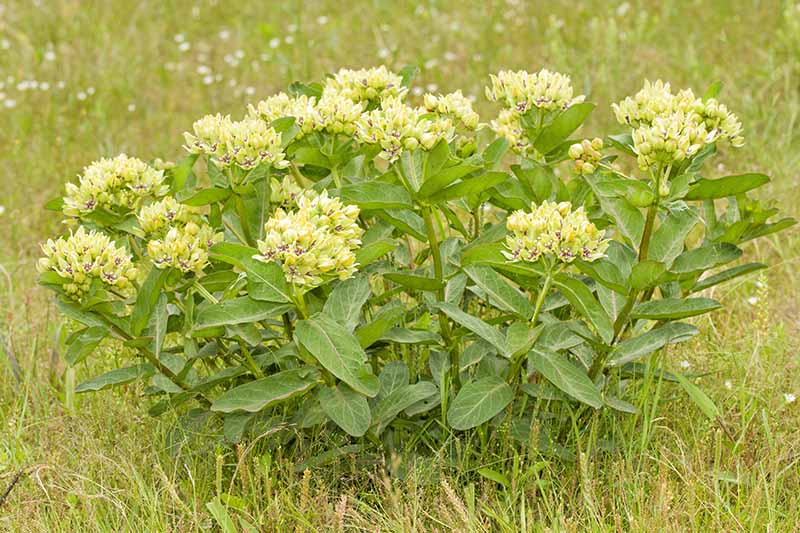
Like antelope horns mentioned above, A. viridis is sometimes called “green-flowered milkweed.” And like that plant, its blooms have a greenish tint, giving it its most common name, “green milkweed.”
Also like antelope horns, A. viridis is sometimes called “spider milkweed,” since crab spiders (species in the Thomisidae family) like to hunt on its flowers.
And adding to the potential confusion when trying to ID and differentiate these two plants, green milkweed is also called “green antelope horn” for the shape of its seed pods. I assure you though, these are two separate species!
A. viridis is hardy in Zones 5 to 9, and is native to the central and eastern central US, including Alabama, Arkansas, Florida, Georgia, Illinois, Indiana, Kansas, Kentucky, Louisiana, Mississippi, Missouri, Nebraska, Ohio, Oklahoma, South Carolina, Tennessee, Texas, and West Virginia.
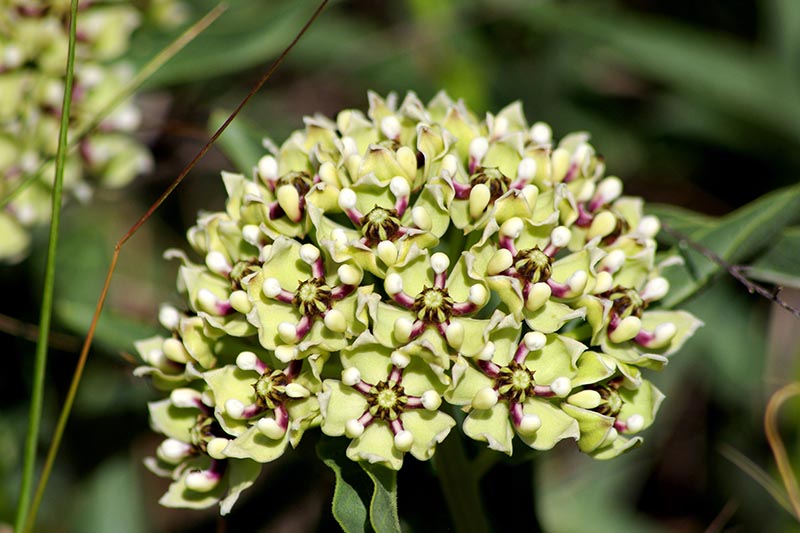
Plants reach one and a half to two and a half feet tall and have a spreading, open growth habit, bearing medium-green, oval- to lance-shaped leaves. The margins of these leaves are sometimes wavy.
Blooming from May to July, flowers are pale green with rose or purple centers. The flowers are held in irregular clusters, and there is usually just one cluster per plant.
Green milkweed is drought tolerant and can thrive in soil that has a low to medium moisture content.
This plant requires full sun and well-drained soil. However, soil quality can range from rich to poor – either way, it will make itself at home.
A. viridis will self-seed, so plant it somewhere where you’ll be happy to see it spreading. Otherwise, seed pods can be removed before they have a chance to spread.

Is this green-flowered beauty the one you need? If so, you’ll find green milkweed seeds available for purchase in an array of pack sizes from Everwilde Farms via Amazon.
A Royal Choice Among Wildflowers
Now that we have covered the map of the US (and beyond!) with different milkweed species, all that remains is for you to note the best plants for your location and your growing conditions – and make your royal choice!

Which type of milkweed are you going to grow? Let us know in the comments section below.
Do you need help identifying a species of milkweed? If so, be sure to post a photo and let us know what region you are in.
If you’ve observed any monarchs on your milkweeds, we’d love to hear about this too. The more monarchs the merrier!
And for more information about growing milkweed in your garden, check out these guides next:
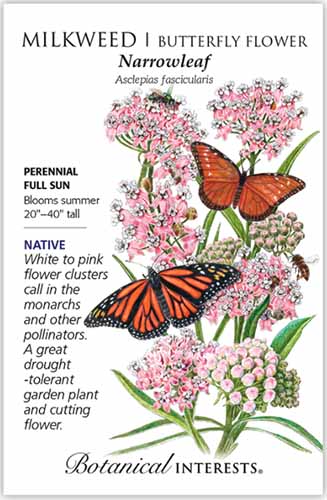
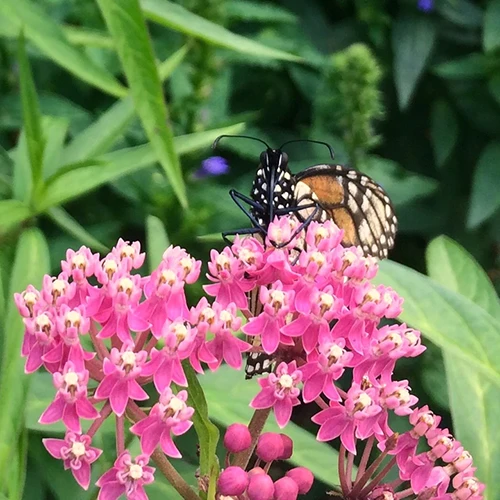

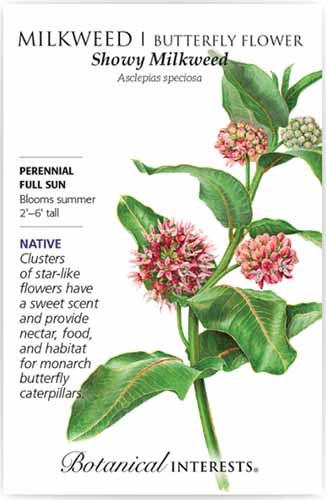
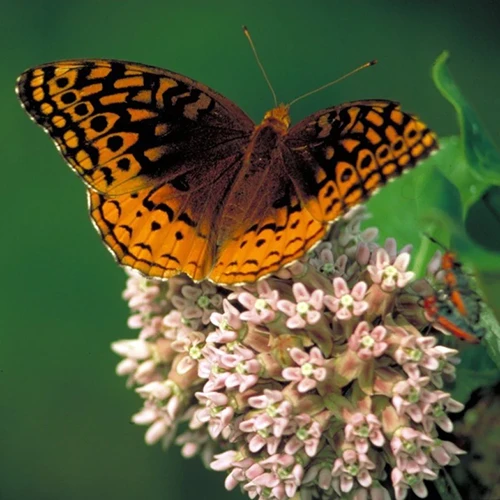
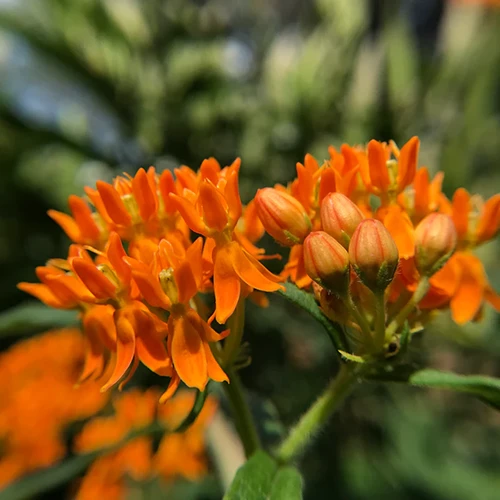

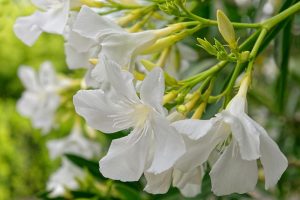


Thanks for a great breakdown and information on milkweeds! Never knew there were that many. PS – Prince’s home state was Minnesota.
Hi Terese,
Thanks for your comment, I’m glad you enjoyed the milkweed info!
And oh my goodness, thanks for pointing out my mistake! We will get that corrected asap. I’m very grateful for readers like you!
I’m very grateful for rare botany wonders like you.
A visit to the garden center yesterday left me with the question should I have more than one type of Milkweed? This was the second article that popped up on my search. All I can say is wow! I could not have asked for a more complete guide to milkweed. I now know that the little “needley” things slowly growing amongst all the tuberosa are whorled milkweed. I know I need to go back to the nursery and grab a couple of those swamp milkweeds. I know which seeds to get to grow my own and where to get them.… Read more »
Rich,
Thanks for your wonderful comment – it made my week! Your vision for a 15′ x 15′ milkweed patch is glorious. Please feel free to jump back on here in the future and share some photos to inspire other readers. Best of luck with your milkweeds – and thanks for helping the monarchs!
Thank you for this article, but only one if the milkweeds you posted grows in South Florida, zone 10a, and it requires a bog garden. Are there no others that thrive down here?
Hi Lauren,
Thanks for your message and question. Number 13 in this article, butterfly weed (A. tuberosa) is native to South Florida and doesn’t require bog conditions. It has a very wide native range and is quite adaptable!
It’s recommended by the Florida Wildflower Foundation and is also included in the LadyBird Johnson Wildflower Center’s recommended plants for South Florida.
Whorled milkweed (#14 in the article), and Green flowered milkweed (#15) are also native to South Florida.
I hope this helps!
I live in Salt Lake City and what are the best milkweed plants to buy for monarchs & honeybees
Hi Maurice, I would recommend showy milkweed and butterflyweed (numbers 11 and 13 in this article) for your area. One has pale pink flowers and the other has orange flowers, so you can pick which color you prefer for the rose garden.
Hope this helps!
And to mix in rose gardens
Growing Asclepias Curassavica in Central mexico (Ajijic) Jaiisco. Findiing that after leaves grow long and tall they develop a powdering mildew on underside. Butterflys are hatching small and not living once they leave the cacoon. Very small cacoon. What other milkweed should I try here?
Hi Eloy, Thanks for posting your question here, you have a very interesting situation and I’m hoping we can be of help. I don’t know the milkweeds of Mexico so well, but I did a little research for you. Here are some species of milkweeds that are native to Central Mexico (and thus, more likely to grow well there.) I’m also including the type of biome they grow in since I don’t know your area – you can see which ones seem like the best fit: Asclepias glaucescens – subtropical biome Asclepias angustifolia – subtropical biome Asclepias oenotheroides – seasonally… Read more »